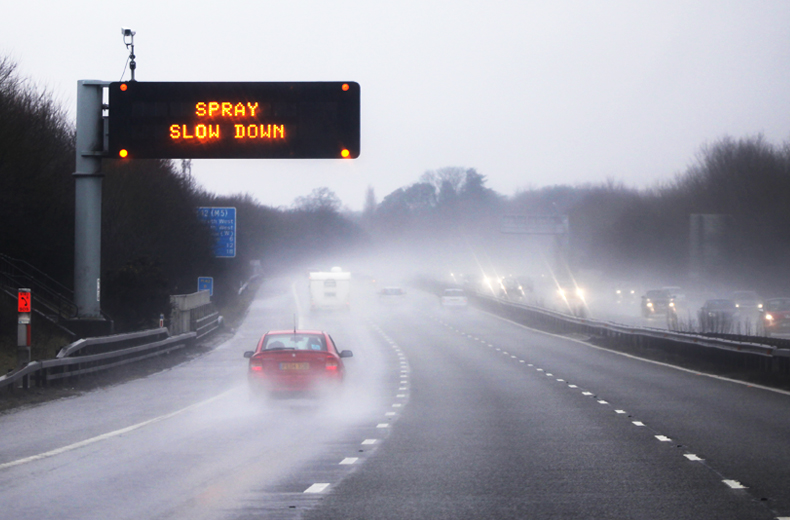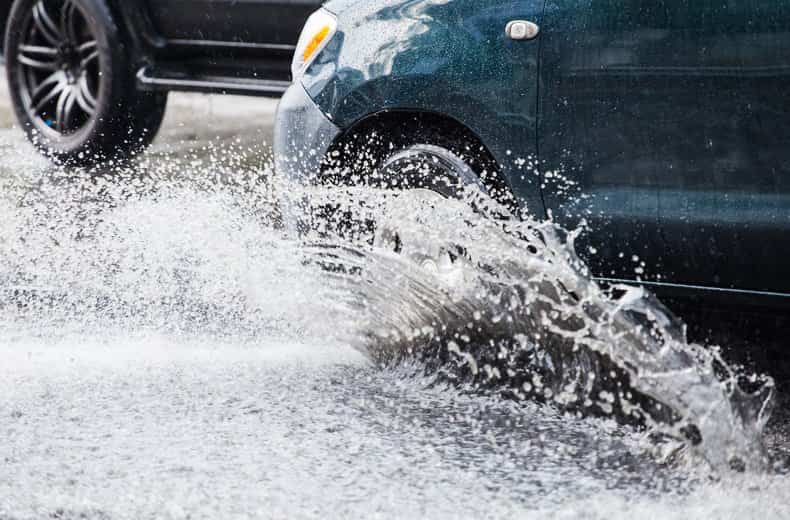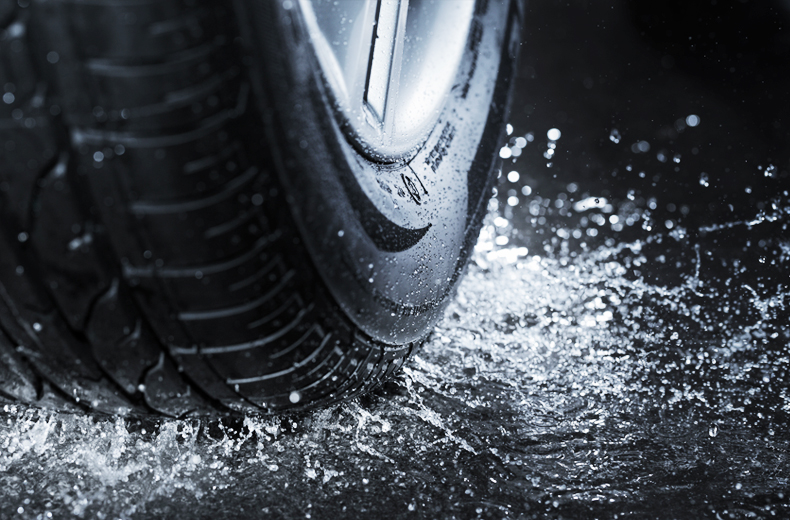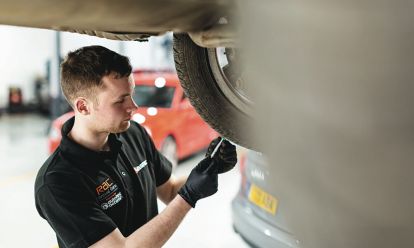It’s important for any driver to take some time to consider what aquaplaning is, how to act if it were to occur when they are behind the wheel and what they can do to avoid it ever happening in the first place.
To keep you safe, we've created this winter driving guide to help you avoid aquaplaning when driving in wet weather conditions.
What is aquaplaning/hydroplaning?
Aquaplaning/hydroplaning happens when a layer of water builds between a vehicle’s tyres and the surface of the road.
At this point, the tyres lose grip with the surface of the road and lose traction. In a worst-case scenario, aquaplaning will result in a total loss of control of the vehicle, with the driver losing the ability to steer, brake or accelerate.
Aquaplaning can be quite a frightening experience and can cause a serious accident if the vehicle is travelling too fast or the tyres do not have the legal minimum tread depth of 1.6mm.
What causes aquaplaning?
Aquaplaning can be caused by heavy rainfall building up on a road’s surface or by pools of water where there are holes or ruts in a road.
The risk of aquaplaning is increased by two key factors – the condition of a vehicle’s tyres and the speed that the vehicle is travelling.
The tread pattern on tyres are designed to disperse water and prevent aquaplaning; however, if the tyre tread wears below 1.6mm (the legal limit in the UK), it loses its ability to disperse water from beneath the tyre.
You should check your tyre tread depth regularly and ensure all meet the legal requirement across the complete circumference.
Travelling too fast in wet road conditions will also increase your risk of aquaplaning. According to tyre manufacturer Pirelli, driving at under 35mph will significantly decrease your chances of losing control due to aquaplaning.
How do you know if your car is aquaplaning?
When driving on a wet road you might:
- Hear your engine suddenly become louder
- Feel like you’ve dropped the clutch down the gears while driving at speed, causing the revs to increase
- Feel the steering become ‘light’
- Experience the back end of the car drifting from side to side – known as ‘fishtailing’
MORE: Clutch repair

RAC sale – up to 33% off*
• Roadside cover from £5.29 a month†
• We get to most breakdowns in 60 mins or less
• Our patrols fix 4/5 breakdowns on the spot

How to control an aquaplaning vehicle
If your car starts aquaplaning, don't panic - follow these tips to help control an aquaplaning vehicle:
- Do not brake or accelerate hard
- Gently ease off the accelerator
- Hold the steering wheel straight
- Switch off cruise control mode if you have it on
- When the car begins to gain control you can begin to brake to bring your speed down
Once you’ve realised that your car has started to aquaplane it’s important to keep your cool. If you try to do something drastic – hitting the brakes hard or twisting the wheel suddenly – you could cause your car to skid or slide into a collision.
Instead, it’s important to hold the steering wheel straight and gradually ease your foot off the accelerator. As you slow down you should be able to feel your wheels gaining traction and you’ll get back control. As this point it’s safe to make slow and steady movements of the steering wheel and gently use your brakes.
If your car has a cruise control mode then it’s a good idea to switch this off when driving in wet conditions. If your car is aquaplaning and this is on then you should switch it off as soon as you notice the four issues outlined above (this should be done with the button and not the brakes to avoid issues).

How to avoid aquaplaning
There are a number of things motorists can do to avoid aquaplaning - both in terms of driving technique and maintaining your vehicle, key points include:
- Inspect the tread depth of the tyres regularly, they must meet the 1.6mm legal limit
- Check your tyre pressures, they should always be inflated to the manufacturer’s recommended level
- Don't drive too fast, exceeding 35mph will increase the risk of aquaplaning
- Avoid sudden actions, braking hard will increase the risk of aquaplaning
Five tips to help avoid aquaplaning
Here are five helpful tips on what preparations you can undertake to ensure you avoid aquaplaning.
1. Understand the conditions
Always check the weather conditions before you drive, paying particular attention to the conditions that you might encounter further along the way when undertaking a longer distance drive.
You’ll also be able to see and feel when the driving conditions change – and things such as spilt oil or mud on the roads can all be exacerbated by rainfall. Make sure you react to the warning signs in front of you and alter your driving technique according to the weather and road conditions.
2. Watch your speed
Your tyres will have less chance of gripping to the road if you’re travelling at a higher speed.

There’s no specific ‘aquaplaning speed limit’ that you can stay below to avoid this but it’s thought that a vehicle moving at under 35mph in an inch or two of water will be able to keep enough traction to avoid aquaplaning, while one moving faster in the same conditions is much less likely to stay in control.
Remember, too, that stopping distances can double in wet conditions, so it’s important not to drive too fast and get too close to the vehicle in front.
3. Keep your tyres in good condition
As we’ve discussed above, tyres in a poor condition can contribute towards aquaplaning as they might struggle to clear enough water off the road.

As a result, it’s important to regularly check your tyres to make sure they are in good condition and are properly inflated. Your car manual will tell you what your vehicle’s tyre pressure should be – or you can type your registration into the Tyre Pressures website - and you can easily check this at most petrol stations.
The legal tyre depth is 1.6mm but it’s not ideal to leave them until they reach this level, especially for wet conditions.
4. Follow the track
If you’re following a car in front then their tyres will probably make ‘tracks’ in the water.
This is where they will have already displaced some of the rainfall so, by following the tracks – at a safe distance – you can reduce your chances of aquaplaning.
5. Smooth driving
Driving a lower speed will help, but so too will driving smoothly. Sudden and drastic changes in direction are not a good idea at the best of times, but especially not on wet roads.
You need to pay particular attention to bends in roads and be aware of the techniques mentioned above so that you know how to react should your vehicle begin to aquaplane. It’s also a good idea to avoid using cruise control when driving in wet conditions.
By understanding what aquaplaning is, how to avoid it and how to regain control if it were to occur you’ll be in a better position to drive safely in the wet conditions often experienced on the roads in the UK.
Read next: how to drive through puddles and standing water properly
Service, repair or MOT?
You can trust the RAC with our local approved garages and NEW mobile mechanics.









